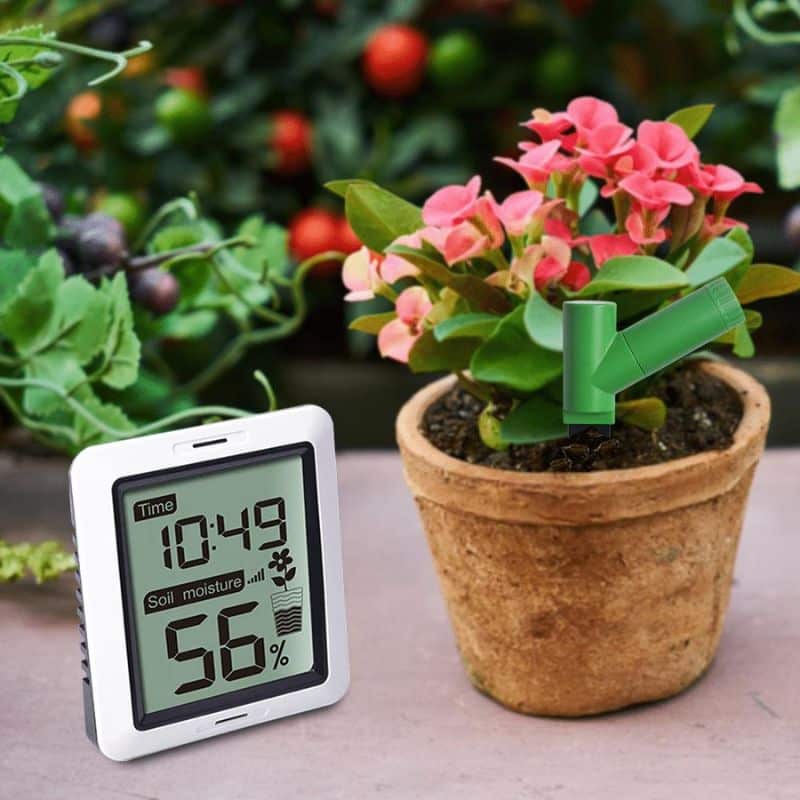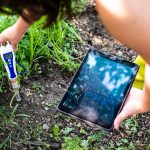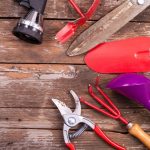Watering or irrigation is a key gardening practice that supplies the water into the soil for plant uptake. This is crucial for most flowering plants grown indoors since they lack exposure to natural sources of water like rain and they have limited growing media in the pot.
Many people who enjoy plants and have just begun gardening get discouraged because a misstep at what seems to be a simple task can easily kill a plant.
It’s a good thing that there exists a device that takes the guesswork out of watering and can be operated by a gardening newbie. A soil moisture meter is a gardening tool that determines when the plant may need water.
You may be excited about owning a water meter that will help you know when your plant babies are thirsty but still wondering where to start and which to pick. Allow us to guide you through the different kinds of soil moisture sensors, their functions in your garden, and which ones are perfect for you and your plants.
What is a Soil Moisture Meter?
When water is limited or overly supplied, plants will be stressed which can ultimately lead to poor quality or death. Soil moisture meters or sensors are sensing devices that provide information on the soil water available to plants (1). They can determine either water availability or actual water content in the soil so that irrigation will be performed properly.

Four types of moisture sensing technologies such as tensiometer, granular matrix sensor, dielectric sensor, and heat-dissipating sensor are used for agricultural and large scale farming (2). These sensors can give exact measurements and suggest watering schedule but they tend to be intricate in design and are quite expensive.
There are also soil moisture analyzers more appropriate for household and small scale gardens. Although they do not indicate detailed information about the soil moisture levels, they provide what is necessary, easier to operate and cheaper too.
Benefits of Using A Moisture Sensor
Soil moisture is an important factor in any plant’s growth. If moisture in the soil is at the considered optimum amount, plants can readily absorb water to support processes like photosynthesis and transpiration and even control exposure to pests and diseases.
Feel method is a reliable way of gauging if it’s time to water the plants. By inserting the forefinger into the soil up to the knuckle, you will know if the soil in the root zone is dry and needs to be watered. But this method can be subjective and only works for plants in medium-sized containers.
Soil moisture sensing tools are more scientific and can be used in any gardening scenarios, both indoor and outdoor. They provide immediate and accurate results and they are relatively easy to use. By successive monitoring of the available soil moisture, watering intervals can be tracked will aid in the irrigation scheduling.
Using moisture sensors help us to water plants properly for healthy growth and pristine appearance. At the same time, irrigation becomes more efficient thus minimizing water consumption.
Top Soil Moisture Meters for Potted Plants and Garden
#1. XLUX

A simple soil moisture measuring device, the T10 Soil Moisture Sensor can be used by any gardener for outdoor and indoor potted plants. XLUX soil moisture meter is also one of the functional sensors at the lower end of the price range. The single probe attached to the device does not disturb the plant root system and can be easily cleaned by wiping.
After inserting the metal probe 3-4 inches into the ground, the moisture level will be readily indicated on a scale of 1 to 10, 1 the driest and 10 the wettest. It is also color-coded to quickly gauge when to water.
While this instrument provides a helpful indication of soil moisture needs, it’s important to note that it doesn’t measure soil moisture content exactly. The length of the probe is 7 inches and can only be inserted up to 4 inches so even if it can be used outdoors, it may not be effective for deeper rooted plants.
#2. Sonkir

One of the most popular moisture devices for the garden, the Sonkir MS02 does not only test for soil water content but soil pH and ambient light level too. The double-needle design speeds up analysis of moisture and pH and is long enough to reach the soil system of plants in large pots as well as in plots outdoors.
The simple design is a preference among gardeners and the capability to measure 3 different garden conditions at an affordable price makes this moisture meter worth-buying. It comes with a 12-month hassle-free money back or free new replacement guarantee too!
Since the monitor has two probes, inserting it into the soil may be quite tricky, especially when the soil is mixed with sand and pebbles. It may also cause, albeit minimal, damage to the root system. Also, there are no spare parts and options to calibrate the device should it malfunction.
#3. Dr. Meter

This analog moisture meter does not require batteries so you can check your plant hydration whenever you want. The meter window also features an easy to read color-coded scale of 1 to 10, red for dry, green for moist, and blue for wet which is favorable for gardeners who do not like the complication of many hygrometers. There is also a hole at the top for hanging in your storage cabinet.
Since this is a basic moisture meter, there is no way to calibrate the device for an accurate reading. This soil moisture meter takes 15 minutes to get a stable rating which may take a while if you are going to work on 10 to 15 pots of different plant types. The device is also relatively cheap but there were reports that the device started to malfunction after a couple of months.
#4. Gain Express

This dual meter from Gain Express hits two birds with one stone by measuring the soil pH and moisture level in one go. Upon inserting the electrode into the soil, the dual meter rates the soil wet to dry on a scale of 0-8 and accurately indicates the pH reading. The probe is about 11 inches long so it is ideal for plants with a well-established root system.
This device is among the most expensive plant moisture meters in the market. It also shows the moisture level faster than the soil pH. The protective case of the meter is made of plastic which may easily break if too much pressure is exerted while doing tests.
#5. Luster Leaf

The Luster Leaf moisture meter is a reliable digital device that instantly measures the moisture level of the soil. It is perfect for inexperienced plant growers since just seconds after activating and inserting into the soil, it will show an accurate read-out.
The device also comes with a guide on how to interpret the reading, when to water as well as the water requirement of over 100 plants for indoor and outdoor gardens.
The needle is only 4 inches long so it will not reach the root zone of many outdoor plants. The electrode is also quite sensitive and a rocky or sandy soil causes it to show inaccurate readings. Since it is digital, the battery will need replacing later on.
#6. Blumat

The Blumat 50205 is one of the best soil moisture meters that operates using the tensiometer principle – the lower the number readings, the wetter the soil. It accurately recognizes the level of moisture near the root zone so the amount of water to be applied can be exact and it works for larger shrubs and trees. It can be left inserted in the soil for regular moisture monitoring.
This device is expensive for house plants and indoor gardening per se, but cheaper than most tensiometer-based meters in the market. It is not waterproof and since it is meant to be left outside, a meter cap is necessary to avoid water damage.
#7. Sustee

The innovative and award-winning design of the Sustee Aquameter allows it to indicate soil moisture without using batteries or electric currents. After inserting the device into the potted soil and then watering, it will absorb moisture via wick system and the indicator will change color to indicate a well-watered plant. Only when the indicator turns white again should the next watering commence.
The device can be left in the pot to continuously monitor the moisture. It comes in different sizes, perfect for small to large potted plants. The colors available are stylish and the device itself is minimally designed so it can easily blend in with the plants.
The device only indicates when the water has or is about to deplete and not the exact reading of soil moisture per se. The filter that absorbs the water needs to be replaced every 6 to 8 months. Sustee is also more expensive than most analog meters.
#8. A. M. Leonard

A. M. Leonard Company is known to produce durable garden tools and their soil moisture meter is definitely one of them. It is made of a brass probe and a metal meter case. It has one of the longest probes – 24 inches so it can definitely measure at root level even if it’s of your thriving hardy shrub.
Aside from this, it provides instant and accurate moisture readings and it can be calibrated according to the type of your soil and it operates on both AA and dry cell batteries.
Given that this soil moisture sensor is made of metal, the device tends to be heavier. Once the paint on the case chip off, the metal becomes prone to corrosion too. Because of the long needle, inserting may be more difficult and should be done more carefully. This is also very expensive for a single-purpose device.
#9. Gifkun

For the more adventurous gardener who wants to go DIY, this capacitive moisture sensor is the perfect way to go. It has a built-in voltage regulator chip and an analog signal output. By connecting it with a screen and a motherboard, the moisture level can be identified and the proper amount of water can be applied to the plant.
This type of sensor can be connected to a plant watering system so that you can set it on a schedule without manually doing it yourself. This setup can be left on the plant for continuous monitoring and avoids multiple soil insertion and root disturbance. A pack of 2 pcs of the Gifkun sensor can be relatively cheaper than many analog devices.
Building the device yourself can be tricky and requires research to make sure that the materials are compatible and properly installed. The electronics part of the sensor needs to be protected to avoid incorrect readings.
#10. Elekin

The stylish and simplistic appeal of this plant moisture meter will definitely catch the attention of many modern indoor plant owners. It is lightweight and made of durable materials. It can be inserted into any type of soil and will instantly show the soil moisture, red light for dry soil, green for moist, and blue for wet.
The device can also be left in the soil and can be set in different modes which will signal if the plant already needs rehydration. Also, it is one of the cheapest soil moisture meters available in the market.
The Elekin moisture meter is designed for small potted and shallow-rooted plants so it can only be used indoors. Although the blinking light appears to be an attempt at keeping the device up-to-date, the light is tiny and dim that it can be missed easily.
#11. Garden Basix

This adorable moisture meter indicates that the plant already needs rehydrating by producing sounds that mimic some garden animals like birds and frogs. It can serve as a plant ornament too since the waterproof casing of the sensors is shaped like the animals the sounds are from. It also has a light sensor that detects sunlight so that it will not trigger the alarm at night.
However, it’s important to consider some limitations. The 5-inch probes may only be effective for medium-sized potted plants. They may not reach the root zone of most outdoor plants, limiting their effectiveness in measuring moisture for those settings. Additionally, the sound alarm might be overly sensitive to moisture levels. Plants don’t necessarily need to be saturated with water to the point where the alarm shuts off.
#12. Ecowitt soil moisture tester

The Ecowitt Soil Moisture Tester stands out as one of the best soil moisture meters available. Its digital display provides accurate readings, allowing gardeners to monitor soil moisture levels effectively.
Additionally, it offers a convenient LCD display, making it user-friendly. Whether you’re tending to indoor or outdoor plants, this reliable meter ensures optimal watering practices.
Common Plants and Their Ideal Moisture
Plants have what we call ‘optimum water range’ within which soil water contents should be kept to reduce plant stress and promote optimum growth. To put it simply, the soil should not be too wet nor too dry.
For common flowering plants like aster, heather, lavender, poppy, and zinnia, soil moisture should be within 21% to 40% (3-5). Some species and varieties of daffodil, dahlia, iris, lobellia, and marsh marigold, soil moisture can range from 21% to 80% (3-9). Other plants can tolerate drought and can survive in 0%-20% (1-3) soil moisture like agave, cactus, sedum, yarrow, and yucca.
Most trees and shrubs like holly, juniper, gardenia, oak, and spruce also thrive at 21% to 40% (3-5) moisture while azalea, cypress, dogwood, pine, and willow prefer wetter soil of up to 60% (8) moisture.
Common FAQs
What type of moisture meter is best for plants?
For plants, a moisture meter with a probe or sensor that measures soil moisture accurately is typically considered best. Digital meters with probes that can penetrate the soil easily and provide instant readings are often preferred by gardeners and plant enthusiasts.
Are cheap moisture meters any good?
Cheap moisture meters can be effective for providing a general indication of soil moisture levels, but their accuracy and durability may vary. Some inexpensive meters may not provide precise measurements or may malfunction over time. It’s important to research and read reviews to find a reliable and accurate option within your budget.
What are the disadvantages of soil moisture meter?
Disadvantages of soil moisture meters include the potential for inaccurate readings if not used properly or calibrated regularly.
Will moisture meter damage roots?
When used properly, a moisture meter should not damage plant roots. Inserting the probe or sensor gently into the soil should not cause harm to the roots, especially if the soil is moist and loose. However, care should be taken to avoid excessive probing or disturbing the roots excessively, particularly in sensitive or delicate plants.
References
Close
References
Close
Reference List:
(1) Kujawski, J. “Measuring Soil Moisture.” The Center for Agriculture, Food and the Environment. 2011.
(2) Ling, P. “A Review of Soil Moisture Sensors.” Vol. 12, Iss. 3. Ohio Floriculture Online. The Ohio State University Extension. 2005. Retrieved from https://hcs.osu.edu/sites/hcs/files/imce/files/soil-moisture-sensors.pdf.
Close
*Photo by deyangeorgiev2




